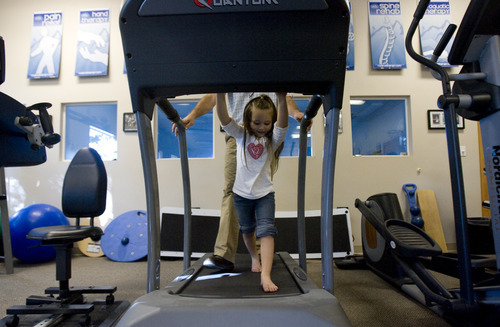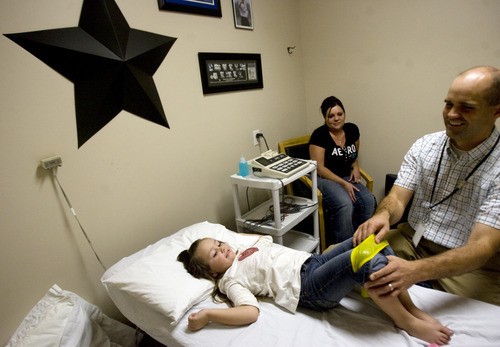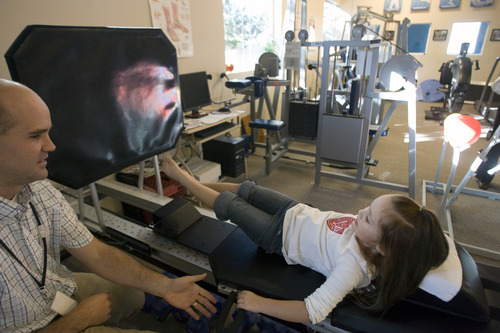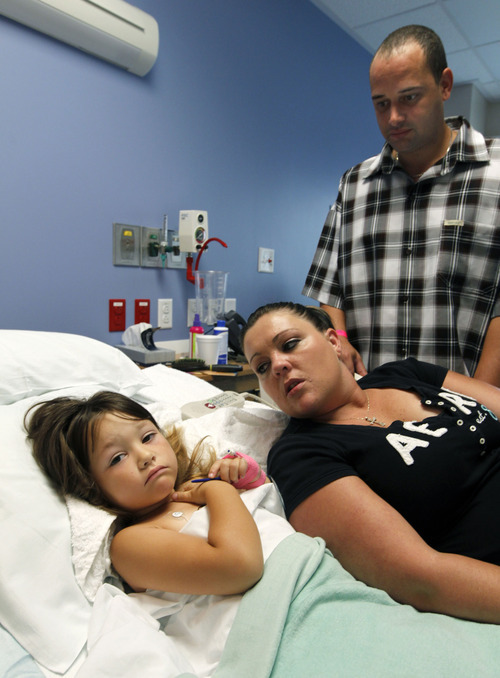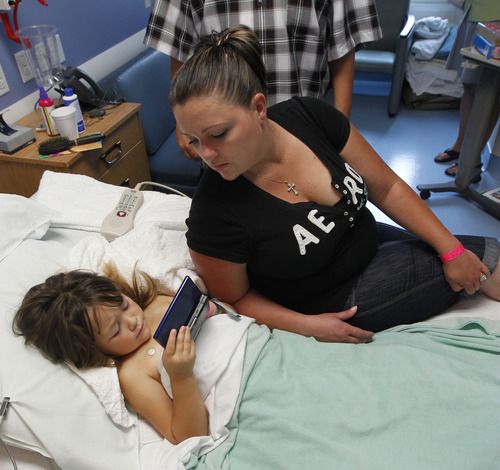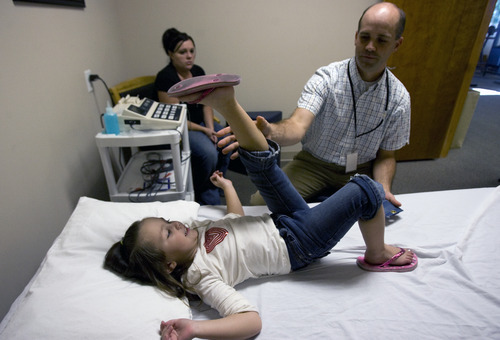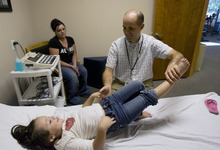This is an archived article that was published on sltrib.com in 2012, and information in the article may be outdated. It is provided only for personal research purposes and may not be reprinted.
Kiarah sits propped up on pillows, her tiny frame seeming to disappear in the sterile expanse of the hospital bed.
The 4-year-old is distracted for now by her Nintendo DS. She's too young to remember the first two surgeries to rebuild her hip, the body casts and having to learn to walk again. "We try hard to insulate her, to make sure she doesn't feel different from other kids," said her mother, Sarah McCoy.
But the well-wishers and balloons will soon give way to months of rehabilitation and piles of medical bills.
Prior to Kiarah's diagnosis with hip dysplasia, McCoy had no debt. Now, despite having better-than-average health insurance, mounting medical bills and related expenses have pushed the 28-year-old working mom to the brink of bankruptcy.
Medical debt is a common burden in America, shouldered not just by the poor and uninsured, but scores of fully insured, middle-class families. It's a leading cause of bankruptcy and well-documented drag on the economy, which industry experts say is getting worse.
And it's uncertain whether federal health reform will bring relief.
"It's a problem that affects everyone but the extremely wealthy, a problem of the 99 percent. And it's a matter of bad luck for the people who incur it," said Mark Rukavina, a former consumer advocate and founder of the hospital advisory group, Community Health Advisors in Massachusetts.
The first hint of Kiarah's hip dysplasia was the click a nurse heard while examining the newborn's hips. But the family pediatrician couldn't replicate the click and dismissed McCoy's concerns, even 10 months later, when she complained her daughter was walking oddly.
After Kiarah's first birthday, an orthopedic specialist confirmed Kiarah had hip dysplasia, said McCoy. "Her hip has never been in the socket, so no cup had developed. It was still the size as a newborn."
The first two attempts to create a socket to grip her femur were only partially successful. Doctors at Primary Children's Medical Center say prospects are better now that she and her bones are bigger, said McCoy.
—
Tapping patients' pockets • The Affordable Care Act aims to reduce medical debt by insuring more people, thereby easing the charity-care burden on hospitals, which will have fewer losses to pass onto paying customers.
The law puts limits on what nonprofit hospitals can do to collect debts and puts new restrictions on insurers, which can no longer deny coverage to the sick or charge them more. Insurers can't impose lifetime caps on coverage, and they have to spend more of the premiums they collect on actual medical care.
"Health reform will probably succeed at reducing many of the large bills," said Rukavina. "But there will still be out-of-pocket costs that eat into people's budgets."
Indeed, the pioneering reform law in Massachusetts upon which federal reform was built may have kept debt in check, but it hasn't solved it.
A survey of Bay State residents who filed bankruptcy in 2009 showed 53 percent blamed medical bills, down slightly from 59 percent in 2007 when the law wasn't yet fully implemented, a study in the American Journal of Medicine showed. But the difference wasn't statistically significant, the authors said.
The Blue Cross Blue Shield of Massachusetts Foundation reported in a 2010 survey that 1 in 5 adults were carrying medical debt and paying it down — statistically the same as in 2006.
Authors of both surveys blamed the high cost of U.S. medical care, which is rising faster than wages and inflation. Feeling squeezed, insurers are passing more of those costs onto consumers in the form of higher premiums, deductibles, co-payments and co-insurance — practices that neither President Obama's health care law nor Mitt Romney's health plan will limit.
Romney's proposal to repeal the insurance mandate and turn Medicaid into a block grant could raise people's out-of-pocket costs because, the Commonwealth Foundation predicts, it will increase the number of people who are uninsured. Romney also would provide smaller insurance subsidies to fewer people and steer more people to cheaper health plans that cover less.
"The trend has absolutely been toward increasing patient responsibility. It's the least likely group to put up a fuss," said Mark Rieger, a vice president at Gateway EDI, a St. Louis-based company that sells software to help doctors better manage their bills.
It used to be that no more than 9 to 10 percent of a physician's income came directly from patients, he said. Now in some parts of the country it's close to 20 to 30 percent.
—
'It's hard to climb out' • Still, health care providers "are only about 50 to 60 percent successful on collecting on patient responsibility," Rieger said. As a result, clinics and hospitals have become less tolerant of past-due balances.
Days before Kiarah's surgery, a clerk at Primary Children's phoned McCoy to ask how she planned to pay for it.
"She said, 'You've met your $700 deductible, but we estimate your portion of the bill will still be $4,000. And because you have an outstanding balance with us, we'll need you to pay that up-front,'" said McCoy, who feared Kiarah would be denied surgery.
Instead, the nonprofit hospital put her on a payment plan. It routinely conveys the expected cost as patients preregister for care, said hospital spokeswoman Bonnie Midget. "Most families appreciate knowing up-front what their portion will be."
McCoy is grateful for doctors at Primary and the hospital's flexibility. A flight scheduler at Hill Air Force Base, she is the sole provider for Kiarah, her 10-year-old sister, Tiyah, and the girls' father, Justin Adams, who is disabled.
But with every payment plan comes interest, and with each surgery, more bills and time off work.
"I've had my wages garnished to pay past premiums on my insurance for when I took unpaid leave. I've maxed out my credit cards to pay the rent and make car payments. My credit is shot, so I can't take out a loan to consolidate my debt," she said. "Once you're in a hole, it's hard to climb out."
Creditors are now hounding her for more than $100,000.
—
'The most common type of debt' • McCoy has hired a lawyer to sue the pediatrician who missed Kiarah's dysplasia. But the case could take years to litigate. Her attorney has recommended that she file bankruptcy.
Data on how many bankruptcies in Utah are caused by medical debt are hard to come by.
But nearly 88 percent of a random sample of bankruptcy filings between 2003 and 2007 reported at least some medical debt, said Levi Pace, a doctoral candidate in economics at the University of Utah, who for his dissertation is researching the effects of changes to bankruptcy laws.
Debts to doctors, hospitals, medical clinics and their collections agencies only accounted for 23 percent of filers' total debt load, Pace said. "But it's the most common type of debt owed … more common than mortgages, auto loans, credit card debt, student loans and payday loans."
Conservatives say the only way to bring down costs is to make people more responsible for their health and providers more accountable for their outcomes and prices.
They argue for tort reform to eliminate the cost of defensive medicine, such as doctors ordering unnecessary tests and treatments for fear of being sued.
But McCoy said if it weren't for her debt, she wouldn't consider suing.
—
'Every day I lose more ground' • Eight weeks after her surgery, Kiarah bounded into a gym for her twice-weekly therapy session at Rock Run Physical Therapy & Rehab Specialists in Roy. She has a pronounced limp, but she's regained full range of motion.
"Let's see what you can do today," said Josh Brown, a doctor of physical therapy.
He asked her to straighten her left leg and lift it as high as she can. "Hold it. Good, I'm going to put a weight on your ankle because you're doing so well," he said.
Brown predicts Kiarah will regain normal use of her leg. But her life will forever be punctuated with hospital visits. Doctors say she'll probably need a hip replacement every 10 years.
Still, her disability isn't fatal, and it need not prevent her from realizing her dreams, said McCoy.
"I used to question, 'Why me?' But spending time at Primary teaches you to count your blessings. There are families out there dealing with worse problems," she said.
But the disabling legacy of debt is another matter.
McCoy has no money for soccer, fun extras or college savings. "We don't take vacations. I had to draw on retirement to pay rent," she said.
She would set up a fund to take donations from families and friends but doesn't know where to start.
"Every day I lose more ground. It's just frustrating. There are people who don't have insurance and who are on state assistance who don't have the problems I'm having," said McCoy. "Do I worry about [Kiarah's and Tiyah's] future? Every single day." Meet more Utahns who struggle with medical debt
Heather Yancey fights her insurer to get her daughter life-saving injections. Mike and Denise McConkay, bankrupt once, hold fundraisers to pay for his transplant. Roger and Harriet Stephens' high-deductible plan left them exposed. Jeff Riehl's lung surgeon was in-network for his insurance — but his hospital wasn't. Coping with medical debt
Don't ignore your bills; it will be harder to settle disputes if you wait.
Make timely payments to avoid scarring your credit.
If you can't pay, you may qualify for charity care or financial aid.
If you don't qualify for help, ask for a discount.
Avoid using a credit card or mortgaging your house to pay medical bills.
Source: Families USA
Resources




